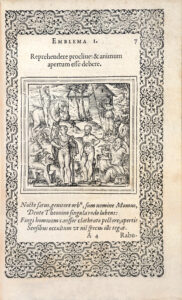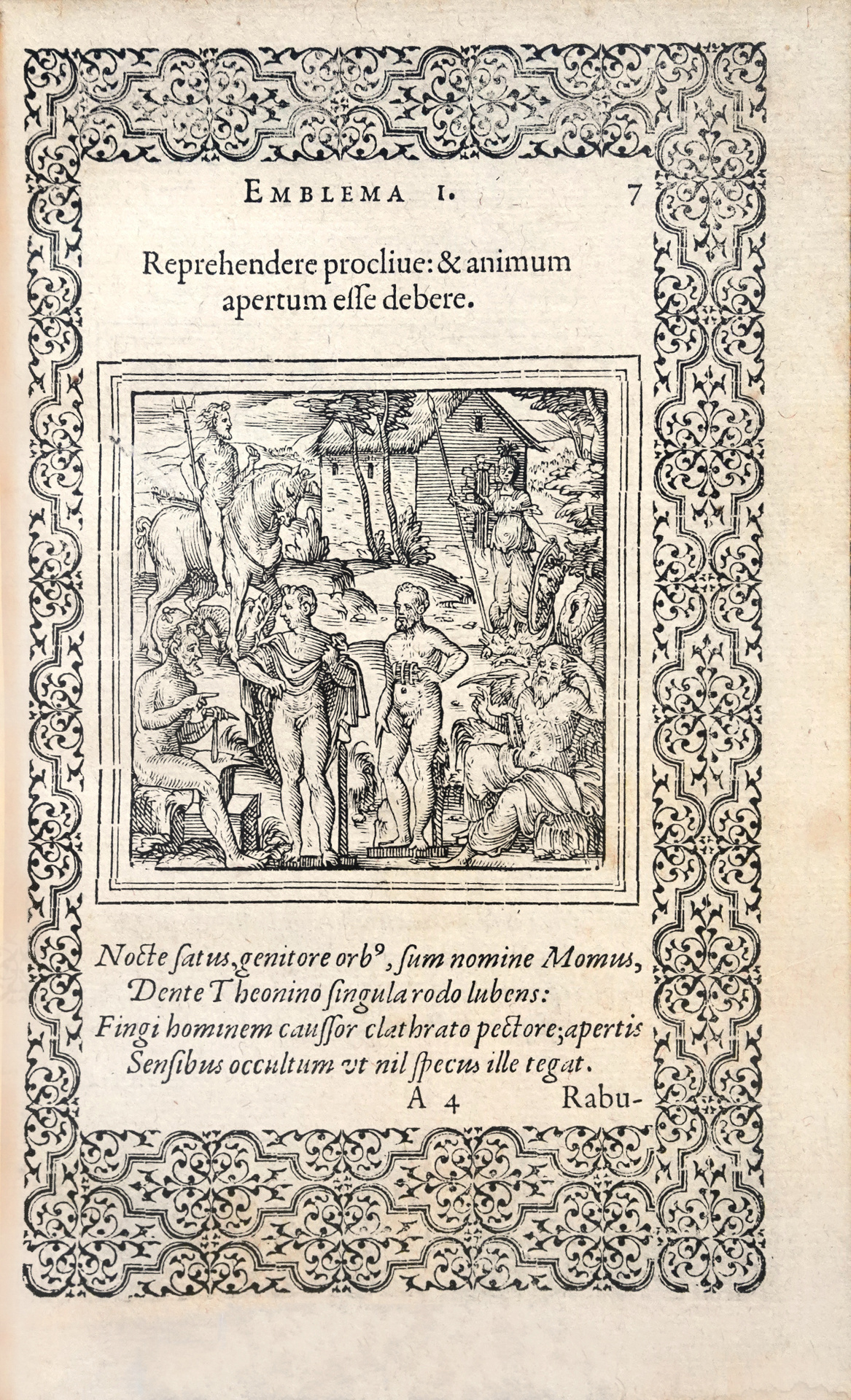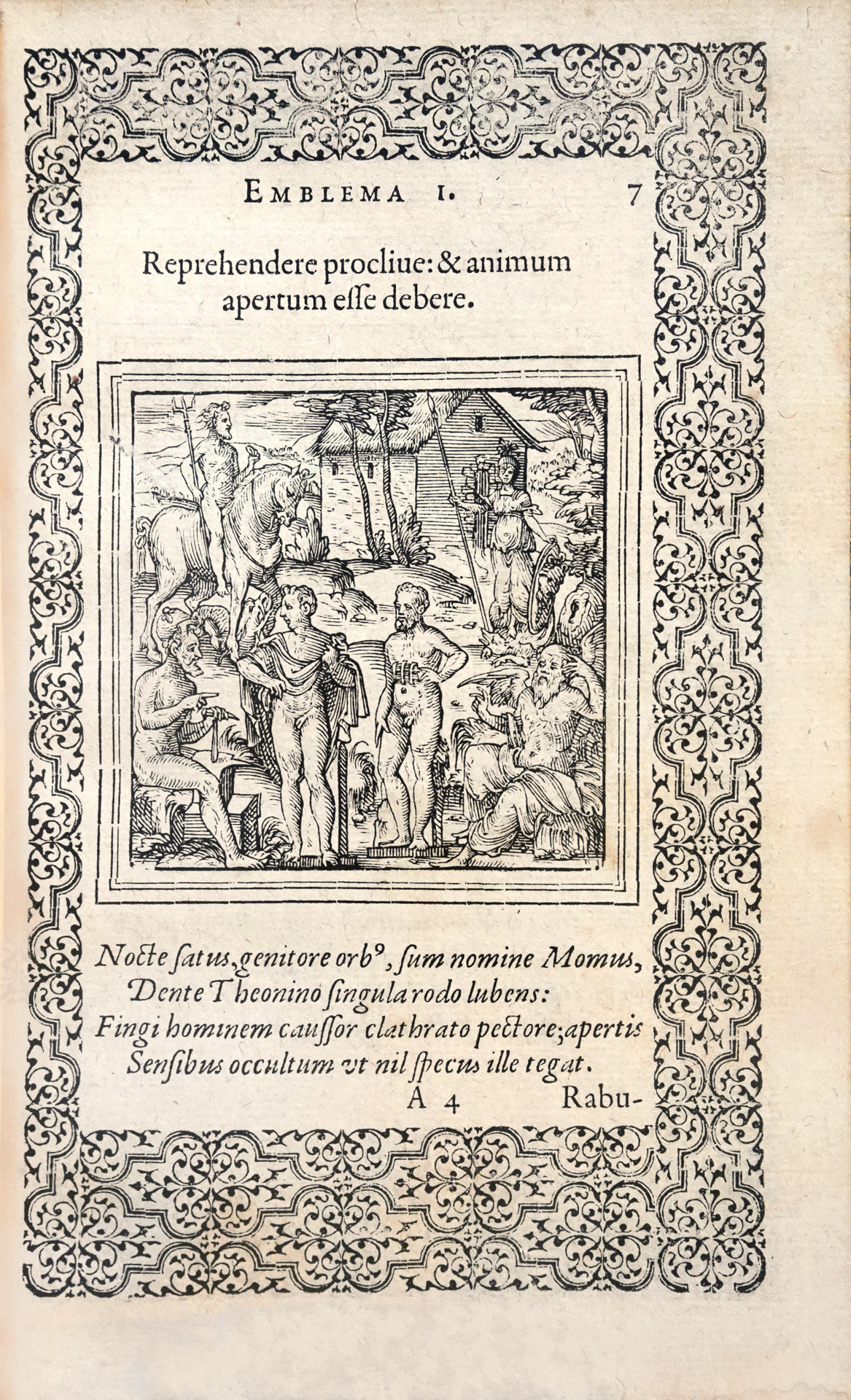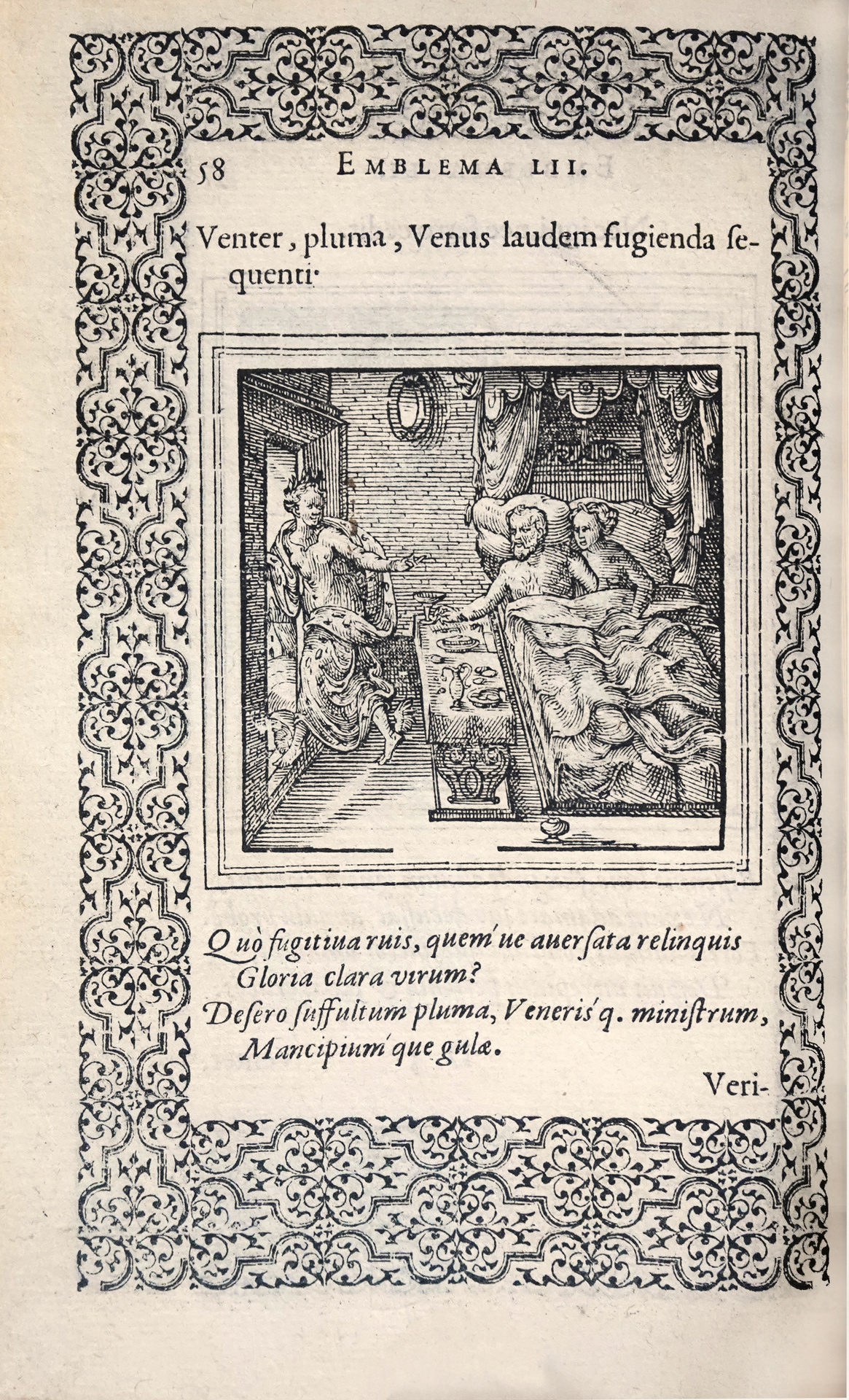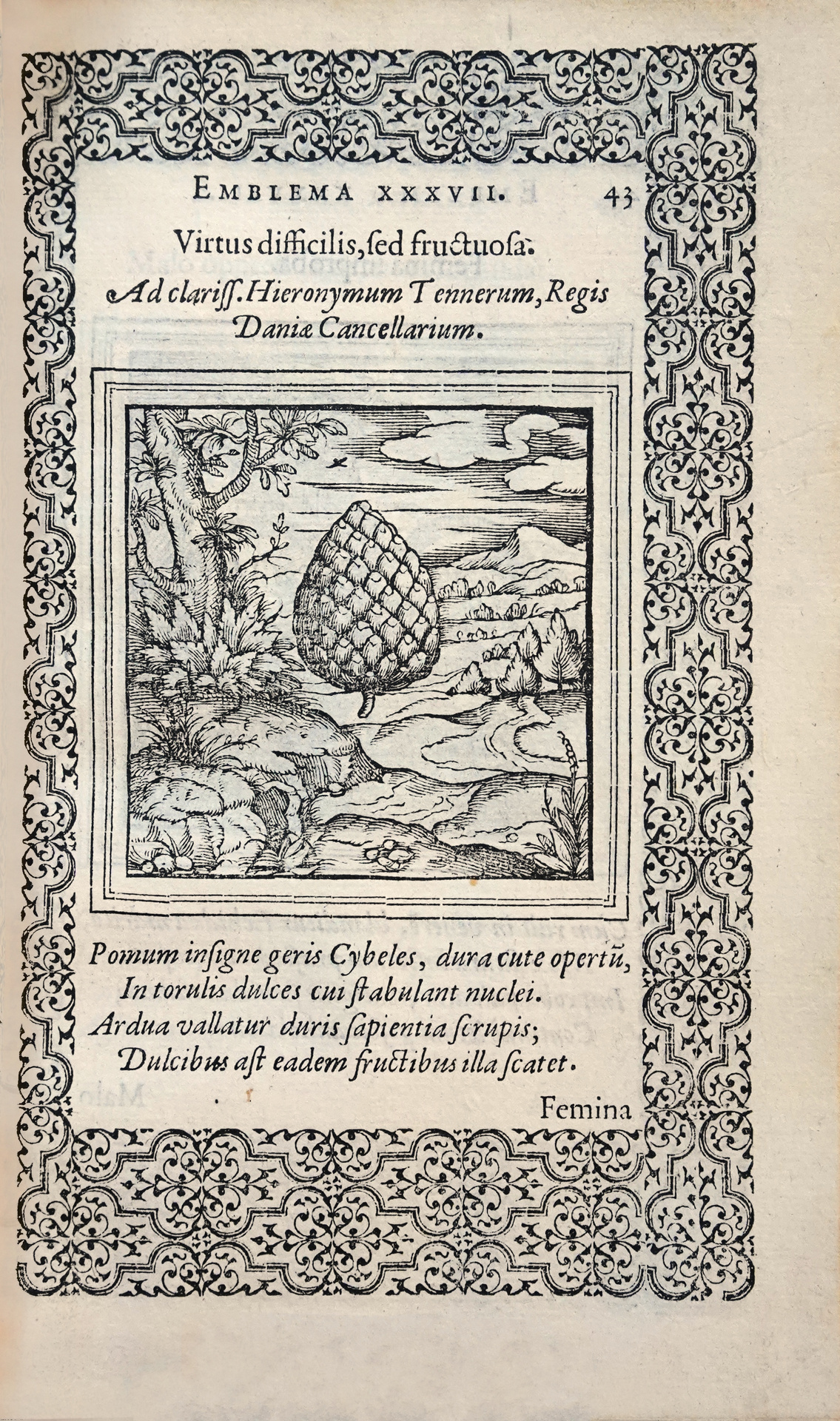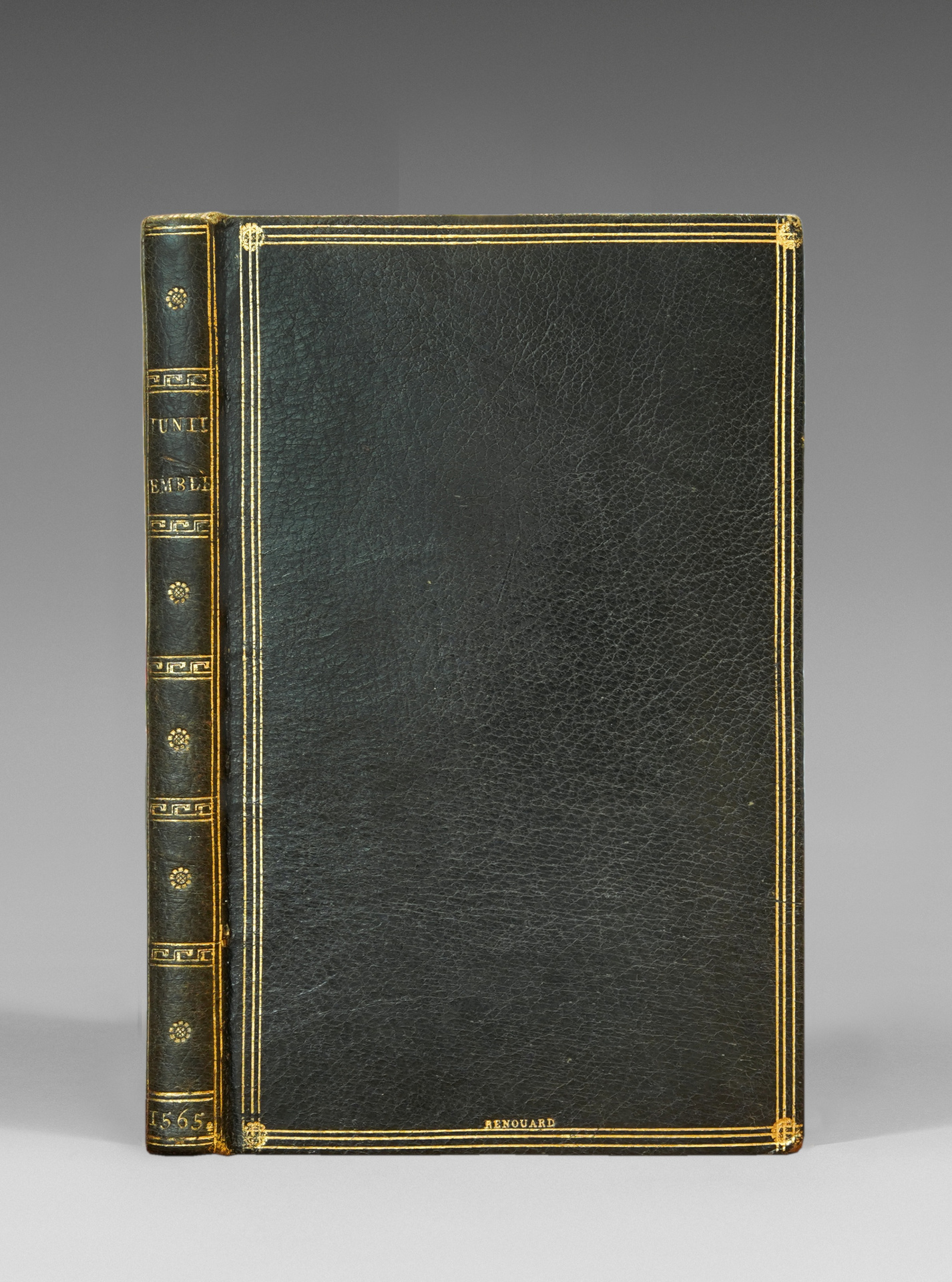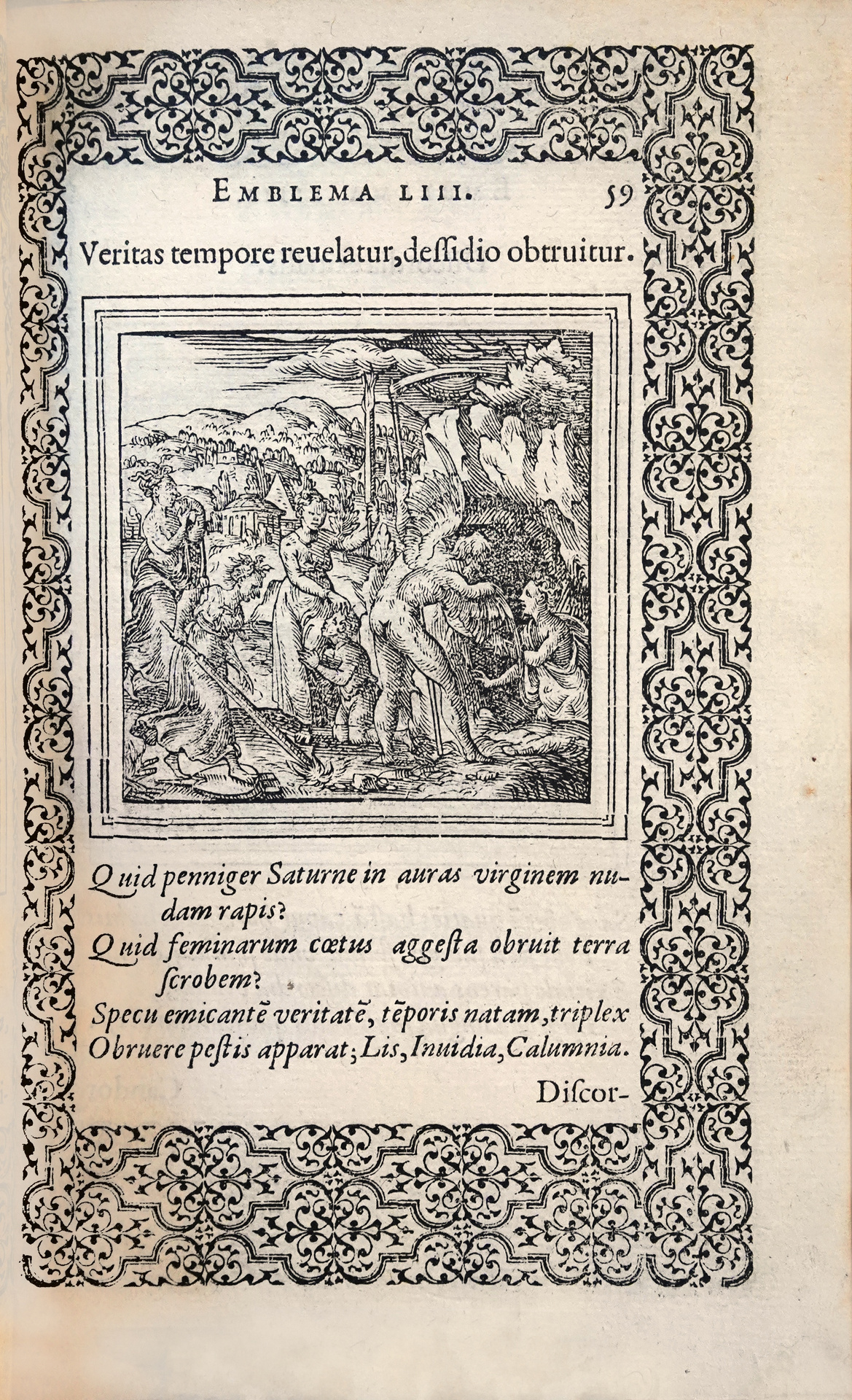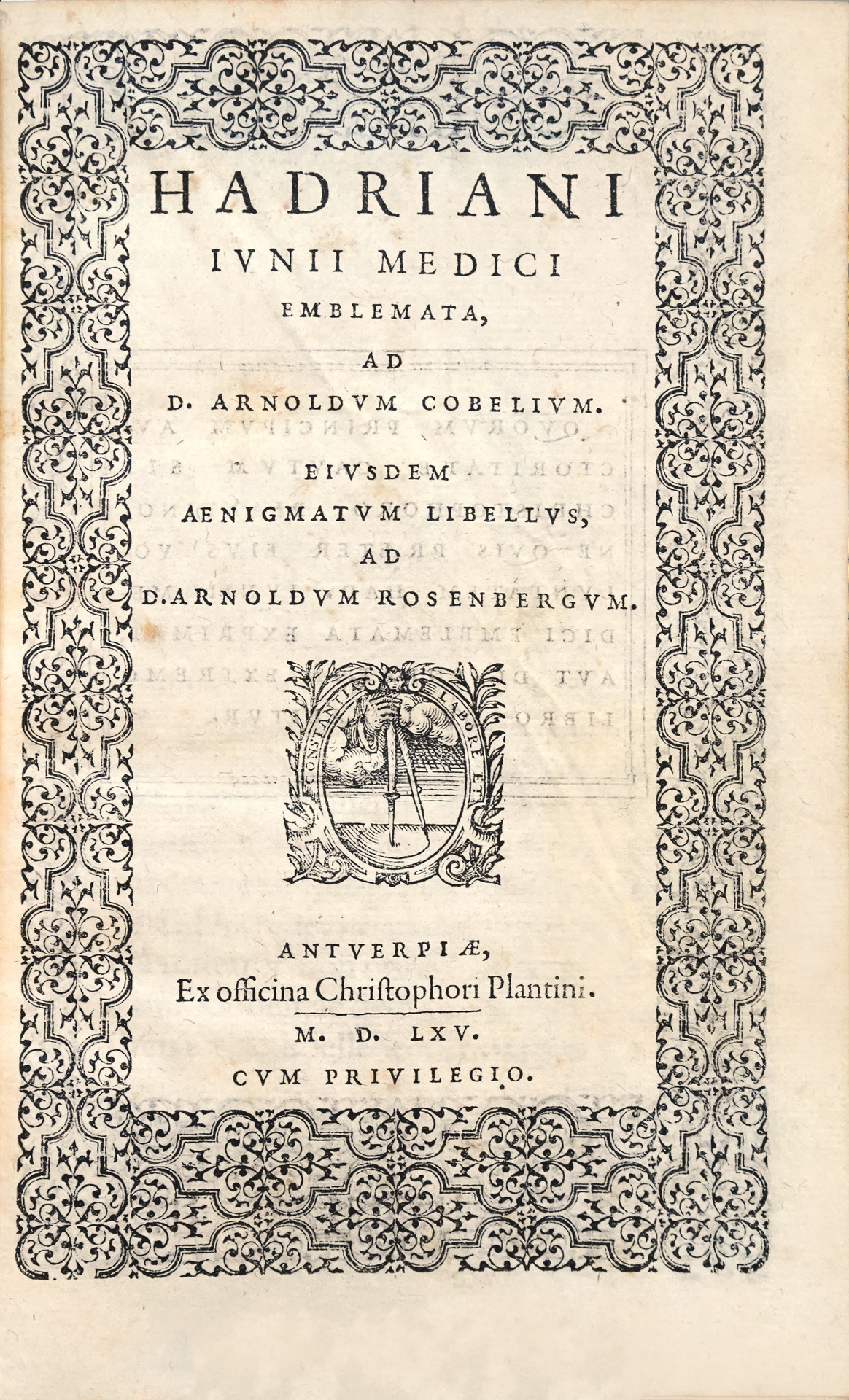Antwerp, Christophe Plantin, 1565.
2 parts in 1 small 8vo volume [163 x 102 mm] of 149 pp, (1) l., (8) ll. Dark green morocco, triple gilt fillet around the covers, “Renouard” in gilt letters at the foot of the front cover, flat ornamented spine, gilt inner border, vellum doublures and endleaves, gilt edges, case with a red morocco spine. Binding from the end of the eighteenth century, modern case.
First edition, illustrated with 57 half-page woodcuts.
Rahir, Bibliothèque de l’amateur, p. 476 ; Chatelain, Livres d’emblèmes et de devises, 1993, n°24 ; Landwehr, Emblem and Fable Books printed in the Low Countries, 1988, n°398 ; Voet, The Plantin Press, III, n°1476 ; Praz I, pp. 384.
Exceedingly rare first issue out of three.
Elegant collection of moral and political emblems executed on the presses of Christophe Plantin. Each page of the text has an ornamental woodcut frame finely engraved. The emblems were engraved by Geerard van Kampen and Arnold Nicolai after compositions by the Parisian Geoffroy Ballain and Pieter d’Huys.
A very rare copy of the first state.
It contains the first state of quire D of which page 64, which should have contained the fifty-eighth and last emblem, was not printed, as well as an error in the legend of emblem 46. Plantin reprinted this quire and replaced it in most copies.
One of the most important emblem books, together with that of Alciat: it was to set the standard for the genre.
“The Emblems of Junius […] were republished many times until the very end of the sixteenth century in their original Latin version as well as in their French translation, which we owe to Jacques Grévin and published in 1567, and their Flemish translation, that we owe to Antoine Gillis” (Jean-Marc Chatelain).
Precious and beautiful copy that belonged to the printer-bookseller and bibliophile Antoine-Augustin Renouard (1765-1853).
Like every book bound for this enthusiast at the end of the eighteenth century, it bears his name in gilt letters at the foot of the front cover; as always, the doublures and endleaves are in vellum skin.
« An expensive compositorial misreading : the reset gathering in Hadrianus Junius »
Emblemata, 1565.
Alison Adams, University of Glasgow
“Hadrianus Junius « Emblemata » first appeared in 1565, published by the Plantin Press in Antwerp. In the admirably detailed description of the first edition, Leon Voet notes that gathering D was reset. Indeed Plantin himself details this in his records and obviously it necessitated extra expenditure in the production of the volume.The earlier state, of which Voet evidently had not seen a copy, his evidence relying on a Quaritch sale catalogue, contains only 57 of the full 58 emblems, and Voet concludes that the reason for the resetting was “obviously the fact that in the first issue the last emblem (no. 58, on p. 64) for one reason or another (very likely because the corresponding woodblock was not available in time) had been omitted”.
The Stirling Maxwell Collection in Glasgow University Library possesses three copies of the 1565 edition, one of which represents the first state. An examination of this copy reveals that in this in the main very carefully executed and accurate edition Plantin had allowed a serious mistake to slip through. Emblem no. 46 here bears the title “Irae maligna philosophia”, instead of “Irae malagma philosophia”, found in the copies belonging to the second state and subsequent editions. Malagma is an unusual word, which perhaps reflects Junius position as a doctor of medicine as well as a man of letters. Literally, it means “poultice”, but here it is used metaphorically to signify “cure” which is manifestly the sense required by the text. That the word was sufficiently unusual that it might not always be understood is supported by the presence in one of two copies in Trinity College Cambridge of an annotation “a molifying plast”. We can then assume that the compositor misread the word malagma in the manuscript for the more common maligna which does not fit the context. Jacques Grévin in his French translation of Junius, first published by Plantin in 1567, was evidently puzzled by the erroneous motto, for in the first edition he does not translate the motto at all. The printer, probably likewise puzzIed, sets the first line of the 5- line subscriptio as a title. But by the time of the second edition in 1570 he must have known the corrected version for he gives as the French motto, “La philosophie est la guerison de la cholere”, a close translation.
It seems likely to me that it was primarily this significant error which necessitated the resetting of gathering D. Voet mentions elsewhere that Junius was sufficiently unwell in 1565 that he could not correct the proofs of his edition of Marcellus De proprietate sermonum which vas printed between January and March 1565 ; maybe he was similarly unable to check over the proofs of his emblems which were printed in April : certainly the error was not picked up during printing, and the full complement (1250 copies) of D containing the error, but minus emblem 58, appears to have been completed. From Plantin’s statement of expenses, it would appear that the reprinting of D took place alongside that of gatherings I and K, in early May. Gatherings E-K contain Junius learned commentaries on his emblems. The fact that gatherings I and K were printed at more or less the same time as the new setting of D would account for the inclusion of the Explicatio for emblem 58 even in all copies of the edition, even though it seems it had not originally been anticipated that the emblem would appear in this edition, since there is no catchword on the preceding page, below emblem 57. Presumably, the missing woodcut had become available in the meantime and so it was possible to incorporate the final emblem, “Assuiditas duri victrix”, dedicated to Junius’ son, Petrus Junius, in the resetting. At the same time, Plantin effected another obvious correction : in the first issue, the page number “61” on D7R had been on the wrong side of the page. In addition, two changes in punctuation are made, on D3R and D7R, “concitat:” for “concitat,” and “amaro.” for “amaro,”. These can probably be regarded as improvements, and certainly constitute the readings that go forward into subsequent editions.
Directly or indirectly, 1 have consulted libraries which, according to the standard reference works, possess copies of the 1565 adition. Of the 39 copies about which I have been able to acquire information, only five correspond to the first state of the edition. Given the fact that the reprinting of D appears to have been done more or less alongside the final gatherings of the work, it is surprising that so many are in circulation, though not surprising that Jacques Grévin, charged with the translation, should have been in receipt of a copy as soon as one was available.
An examination of many différent copies of the second state of gathering D has provided a point of comparison for the two copies of the second state in the Stirling Maxwell Collection. lnterestingly, both are, as it were, rogue copies. SM 658.2, bound in vellum, with gauffered edges, is a particularly fascinating book. It was bound and used as an album amicorum from as early as 1569. This would seem to guarantee the basic integrity of this copy, but in fact, although in other respects it manifestly belongs to the second state, the leaf D4 corresponds to the first. The lack of gauffering on this leaf, which is slightly smaller than the norm, alerts us to the fact that the page has been inserted into this copy, glued at the inner margin to the following interleaved page. In fact, A4, A5 and A6 are similarly glued in and lack gauffering, though here there is no textual variation. The problem is to establish at what stage in the book’s history these leaves were added, presumably to replace pages which had been damaged or lost. It belonged first to Solinus a Sixma in 1569 and there are numerous inscriptions dating from 1569 to at least 1577, and worthy of study in their own right. Most are in Latin, but Greek and even Hebrew are also present as well as several vernaculars. A number are beautifully illuminated with coats of arms and even four portraits. In 1654 the book belonged to Aggaeus a Sixma, and a smaller number of inscriptions are from this later period. The name of an intermediate owner has been erased, but he evidently did not use the book in the same way. It was evidently rebound in about the time of Aggaeus, to assume its present state : a number of blank leaves were added for further use as an album amicorum, at the very end of the volume, and in the rebinding some of the early inscriptions have been savagely cropped. It must be at this stage that the decorative gauffering was done. The appearance suggests that the replaced leaves have been in position at least since the rebinding, since the gluing positions them tightly in to the spine of the book, but, short of taking the binding of the book down, this cannot be proved.
But in terms of the textual history of Junius Emblemata, SM 658 is more interesting. Here two leaves have been inserted from another copy in the earlier state, D3 and D7. Since this copy has a modern Stirling Maxwell binding, it is impossible to say at what stage the insertions were made, and without my particular interest in the D gathering, I doubt whether I would ever have noticed, although the paper is, in fact, slightly different. What cannot fail to arouse our interest is the observation that these are precisely the pages on which the changes of punctuation referred to above are made. This may, of course, be a coincidence. »
Superb copy that belonged to Antoine-Augustin Renouard, with his name gilt-stamped on the front cover (Catalogue de la bibliothèque d’un amateur, 1819, III, pp. 268-269).
Margaret Winkelman, with her ex libris.
